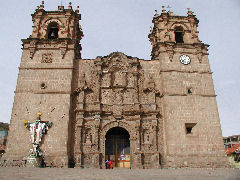 Puno, Peru – Our first day in Puno dawned bright and early… given how early we’d hit the sack, it was about 6:30 a.m. when we both gave up on trying to sleep. Plus we were both feeling the effects of the altitude, so we headed downstairs to the breakfast room and knocked back a couple of more cups of the tea – it really does help. A light breakfast and we headed out into the streets to start exploring this town of 140,000. We started off by heading to one of the few things likely to be open in the morning, the central plaza, Plaza de Armas, and the city’s cathedral. As it turned out we were delayed when we approached by a steady stream of young boys offering repeatedly to shine our shoes.
Puno, Peru – Our first day in Puno dawned bright and early… given how early we’d hit the sack, it was about 6:30 a.m. when we both gave up on trying to sleep. Plus we were both feeling the effects of the altitude, so we headed downstairs to the breakfast room and knocked back a couple of more cups of the tea – it really does help. A light breakfast and we headed out into the streets to start exploring this town of 140,000. We started off by heading to one of the few things likely to be open in the morning, the central plaza, Plaza de Armas, and the city’s cathedral. As it turned out we were delayed when we approached by a steady stream of young boys offering repeatedly to shine our shoes.
Henry gave in after about the fourth one, and that turned in to a nearly hour long process as each of the boys had another opinion about how to clean and shine his shoes… sandpaper seems to one of the most popular, that, along with a different color for polish, resulted in his shoes… changing. I resisted, which after about half a dozen of them had tried, one ran off and came back with a string of teenage boys, who tried to be a bit more bullying about having my shoes shined. But, no. After awhile they gave up, but it was an interesting taste of the local population. And, as soon as Henry’s shoes were shined, the rest of the youngsters started demanding the opportunity to do so again, to try to correct the first boy’s work – so we found ourselves being followed around by a string of them hoping for more work. Give ’em an inch…
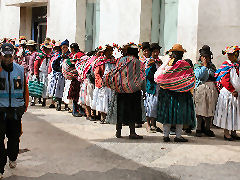 We continued with a brief look around inside the cathedral, and around the plaza (still being followed by shoeshine boys), noting that virtually every tree in any public space we saw was sculpted – topiary is popular in the area. Then we headed for the pedestrian walk and a tour agency that the hotel recommended. We don’t know why, but there was a several block long line of local Aymara women in traditional daily wear, along with probably a couple hundred inside the lobby of the Banco de Credito. Easily 400-500 women just patiently waiting… and pointing out my “hairdo” and giggling… there aren’t a whole lot of guys around with shaved heads. At the agency, for a mere 20 soles apiece (about $6), we booked a morning tour to the Islas de Uros, the floating islands of Lake Titicaca.
We continued with a brief look around inside the cathedral, and around the plaza (still being followed by shoeshine boys), noting that virtually every tree in any public space we saw was sculpted – topiary is popular in the area. Then we headed for the pedestrian walk and a tour agency that the hotel recommended. We don’t know why, but there was a several block long line of local Aymara women in traditional daily wear, along with probably a couple hundred inside the lobby of the Banco de Credito. Easily 400-500 women just patiently waiting… and pointing out my “hairdo” and giggling… there aren’t a whole lot of guys around with shaved heads. At the agency, for a mere 20 soles apiece (about $6), we booked a morning tour to the Islas de Uros, the floating islands of Lake Titicaca.
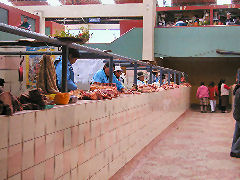 We had a little time to kill until the tour was to leave, so we headed down into the Mercado Central, where everything from butcher shop counters to boxes of pasta, to vegetables, fruits, and, our goal, a pint size bag of coca leaves to chew on as needed. A whopping one sole, or about 30 cents. We headed back to the agency to wait for the bus, which arrived shortly, then meandered about the city picking up folks from their hotels until we had about two dozen of us, along with our tour guide for the day, Erwin, who managed the day with a great sense of humor in both Spanish and English. Then we headed to the main Puerto, where we jumped on a small boat and headed out.
We had a little time to kill until the tour was to leave, so we headed down into the Mercado Central, where everything from butcher shop counters to boxes of pasta, to vegetables, fruits, and, our goal, a pint size bag of coca leaves to chew on as needed. A whopping one sole, or about 30 cents. We headed back to the agency to wait for the bus, which arrived shortly, then meandered about the city picking up folks from their hotels until we had about two dozen of us, along with our tour guide for the day, Erwin, who managed the day with a great sense of humor in both Spanish and English. Then we headed to the main Puerto, where we jumped on a small boat and headed out.
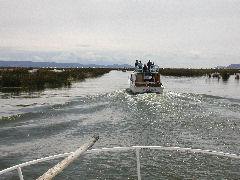 We didn’t get out into the main body of Lake Titicaca, but stayed in the smaller section. First we toured around a bit, just seeing different parts of the area, and then we headed to the Islas Uros. These are a grouping of about 40 man-made islands that are essentially, if wanted, mobile. They’re made out of two meter thick layers of dried tortora reeds that the Aymara harvest from the lake (and continually replenish – at the rate of about 25 centimeters every 3-4 months). Their homes are made of the same materials,
We didn’t get out into the main body of Lake Titicaca, but stayed in the smaller section. First we toured around a bit, just seeing different parts of the area, and then we headed to the Islas Uros. These are a grouping of about 40 man-made islands that are essentially, if wanted, mobile. They’re made out of two meter thick layers of dried tortora reeds that the Aymara harvest from the lake (and continually replenish – at the rate of about 25 centimeters every 3-4 months). Their homes are made of the same materials, 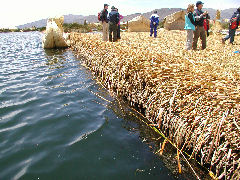 and are not attached permanentaly to the islands, so they can be moved when the “ground” beneath them needs to be replenished. They’re anchored in place by long wooden poles driven through the reeds into the lake bed – none of the islands are in areas where the water is more than about five meters deep. However, in the rainy season, when the lake level rises nearly a meter, some of the islands end up moving to new locations.
and are not attached permanentaly to the islands, so they can be moved when the “ground” beneath them needs to be replenished. They’re anchored in place by long wooden poles driven through the reeds into the lake bed – none of the islands are in areas where the water is more than about five meters deep. However, in the rainy season, when the lake level rises nearly a meter, some of the islands end up moving to new locations.
The islands each hold the homes of a few families, often closely related. Traditional crafts are practiced – and, of course, since it’s a tourist destination, every island has an open air gift market. 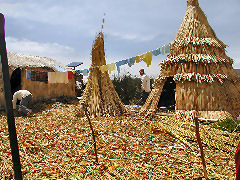 Still, even the teens are actively working on various tasks – in this photo, one teenager is busy roping together the reeds for a new door for his family’s kitchen building (the tall cone shaped buildings). There’s a central island with the public school (in Spanish, since it’s run by the government), a clinic, and church. For high school, the children go into the city (there are water taxi services that run throughout the day). In the modern day and age, this has become a problem for the community,
Still, even the teens are actively working on various tasks – in this photo, one teenager is busy roping together the reeds for a new door for his family’s kitchen building (the tall cone shaped buildings). There’s a central island with the public school (in Spanish, since it’s run by the government), a clinic, and church. For high school, the children go into the city (there are water taxi services that run throughout the day). In the modern day and age, this has become a problem for the community, 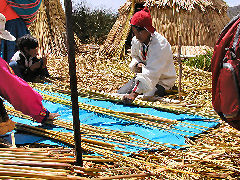 as many refuse to continue to live on the islands after they graduate, seeking out opportunities in the city or elsewhere. As of now, 3-4 of the islands have been abandoned, with families moving on to other islands to consolidate. The islands aren’t quite as primitive as they may seem at first, nearly every home is equipped with a solar panel that powers television, radio, lights, charges cellphones, and apparently in a few cases, satellite connections for internet. Still, it’s a hard way of life, with most transportation via reed boats (saving the taxi fare), and living in year round damp conditions – the average resident develops rheumatism by age forty or so.
as many refuse to continue to live on the islands after they graduate, seeking out opportunities in the city or elsewhere. As of now, 3-4 of the islands have been abandoned, with families moving on to other islands to consolidate. The islands aren’t quite as primitive as they may seem at first, nearly every home is equipped with a solar panel that powers television, radio, lights, charges cellphones, and apparently in a few cases, satellite connections for internet. Still, it’s a hard way of life, with most transportation via reed boats (saving the taxi fare), and living in year round damp conditions – the average resident develops rheumatism by age forty or so. 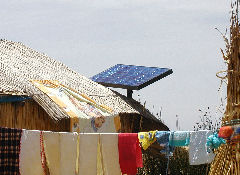 There’s also, obviously, an impact from tourism, both on the way of life, but on the aspirations of the young.
There’s also, obviously, an impact from tourism, both on the way of life, but on the aspirations of the young.
After our tour, we were hungry, and headed back to the main street. Touristy or not, it seems to be the major area for restaurants. There are some strips that we discovered later of more hole in the wall style joins in other parts of town, but mostly they’re limited to pizza and chicken places, with a little chinese-peruvian mix thrown in (here called chifas – adapted from the older Chinese influence of chi fan, or meal, restaurant… Anyway, we found ouselves in for yet another expensive and not particularly interesting meal. Not bad, just not interesting.
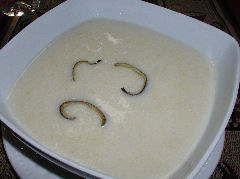
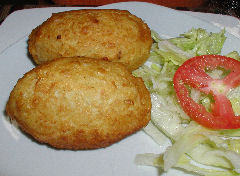
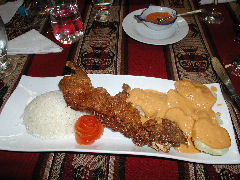
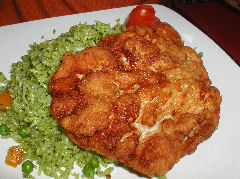
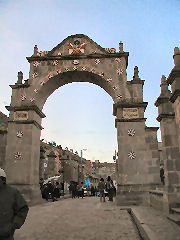 We wandered a bit, checked out the Arco Destua, the city’s last remaining intact entry arch. Pretty. Took a siesta – the altitude was definitely having an effect. We ended up just relaxing for a few hours until later heading back out to wander a bit more – not a lot to see in central Puno actually… no, that’s not fair, but basically, other than a central commercial strip, most of the city is just block or barrio after one another of rundown buildings and poor neighborhoods. Now, I do understand that for the most part, the population of Puno is fairly poor and disadvantaged. What I find a little mystifying, is where all the tourism dollars are going. It’s clear that tourism is a major industry in the city, and the main restaurants and many hotels are charging prices worthy of major cosmopolitan cities. Yet there seems to be no evidence that the money is being spent on anything to improve the city. I can only assume that the vast majority of those who are raking in the dollars, euros, and other forms of currency at those levels, are socking it away elsewhere.
We wandered a bit, checked out the Arco Destua, the city’s last remaining intact entry arch. Pretty. Took a siesta – the altitude was definitely having an effect. We ended up just relaxing for a few hours until later heading back out to wander a bit more – not a lot to see in central Puno actually… no, that’s not fair, but basically, other than a central commercial strip, most of the city is just block or barrio after one another of rundown buildings and poor neighborhoods. Now, I do understand that for the most part, the population of Puno is fairly poor and disadvantaged. What I find a little mystifying, is where all the tourism dollars are going. It’s clear that tourism is a major industry in the city, and the main restaurants and many hotels are charging prices worthy of major cosmopolitan cities. Yet there seems to be no evidence that the money is being spent on anything to improve the city. I can only assume that the vast majority of those who are raking in the dollars, euros, and other forms of currency at those levels, are socking it away elsewhere.
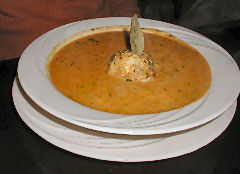 Unlike Argentines, Peruvians tend to eat at what we’d probably consider more normal hours. Restaurants open around 5 p.m. and close by 10 or 11. I’d heard somewhere on an internet forum for foodies that there was one particularly interesting restaurant in central Puno, Coca Kintu, a relatively new, modern, trendy-ish looking space, that serves “nova andina” cooking – i.e., creative dishes inspired by traditional Andean fare. We decided to give it a shot rather than just hitting one of the little hole in the walls. One more expensive meal and then we’d start going for the cheap seats. It was definitely worth entering the place. We started off with a Sopa Incaica, a rich and absolutely delicious bowl of quinoa, chuño, eggs, cream, tomato, herbs… I’m not altogether sure what was in it, but it was a meal in itself and fantastic. [Closed]
Unlike Argentines, Peruvians tend to eat at what we’d probably consider more normal hours. Restaurants open around 5 p.m. and close by 10 or 11. I’d heard somewhere on an internet forum for foodies that there was one particularly interesting restaurant in central Puno, Coca Kintu, a relatively new, modern, trendy-ish looking space, that serves “nova andina” cooking – i.e., creative dishes inspired by traditional Andean fare. We decided to give it a shot rather than just hitting one of the little hole in the walls. One more expensive meal and then we’d start going for the cheap seats. It was definitely worth entering the place. We started off with a Sopa Incaica, a rich and absolutely delicious bowl of quinoa, chuño, eggs, cream, tomato, herbs… I’m not altogether sure what was in it, but it was a meal in itself and fantastic. [Closed]
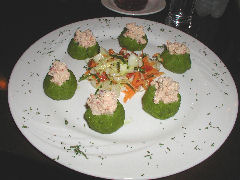 We also sampled their version of a causa rellena. Instead of layering the various ingredients as is traditional, they make interesting round balls of mixed mashed potato, avocado, lemon, and herbs, and then fill a depression in each with a mix of local river trout instead of tuna – far better than the lake trout we’d sampled the night before – something we found as we talked with various people – there are different species of trout in the lake and rivers, all introduced from Canada in the last century or so – and the lake contamination gives the lake trout that muddy flavor. The filling is a mix of the other usual ingredients – trout, chilies, onion, garlic, and olives. Excellent!
We also sampled their version of a causa rellena. Instead of layering the various ingredients as is traditional, they make interesting round balls of mixed mashed potato, avocado, lemon, and herbs, and then fill a depression in each with a mix of local river trout instead of tuna – far better than the lake trout we’d sampled the night before – something we found as we talked with various people – there are different species of trout in the lake and rivers, all introduced from Canada in the last century or so – and the lake contamination gives the lake trout that muddy flavor. The filling is a mix of the other usual ingredients – trout, chilies, onion, garlic, and olives. Excellent!
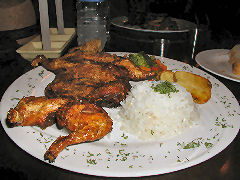 We decided to give the local guinea pigs another shot – after all, with a creative flare, this could be far more interesting than the usual. It was definitely a step up, but admittedly not all that different. Deep fried, though not overcooked, nothing special in the seasoning – a little salt, pepper, and coriander, and served with rice, potatoes, and vegetable. The local diet, by the way, is heavy on carbohydrates – while tourists may be dining on chicken, beef, alpaca, and guinea pig, locals are packing away large plates of rice, potatoes, and noodles – often with little or no sauce, and nothing accompanying them. Vegetables and fruit are almost non-existent in the local diet, and meat is eaten only in small quantities. Part of the reason for a shortened lifespan and many health problems locally.
We decided to give the local guinea pigs another shot – after all, with a creative flare, this could be far more interesting than the usual. It was definitely a step up, but admittedly not all that different. Deep fried, though not overcooked, nothing special in the seasoning – a little salt, pepper, and coriander, and served with rice, potatoes, and vegetable. The local diet, by the way, is heavy on carbohydrates – while tourists may be dining on chicken, beef, alpaca, and guinea pig, locals are packing away large plates of rice, potatoes, and noodles – often with little or no sauce, and nothing accompanying them. Vegetables and fruit are almost non-existent in the local diet, and meat is eaten only in small quantities. Part of the reason for a shortened lifespan and many health problems locally.
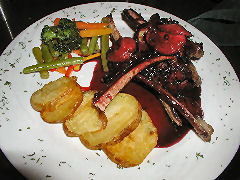 The other plate we sampled was an array of lamb chops in a sauce made from plums, apples, and local herbs. Very good. Like a very fruity barbecue sauce with some different flavors – I think the main herb used was yerba buena, there might also have been something in the mint family – maybe some huacatay? It was served with some undercooked vegetables, potatoes, and stewed slices of apples and plums. Quite good. I’d say, however, that we both thought the appetizers far outshown the main courses. The place also doesn’t seem to be on the radar – while everywhere else in the neighborhood was packed with tourists eating pizza, pasta, burgers, and probably the occasional local dish like some form of alpaca or cuy, this place stayed empty other than ourselves for the entire time we were there. Passing it on other days it was the same – for all I know, we were their only customers during our 3½ days in Puno. A shame, because this was easily our second best meal in town, very creative, and far better than any of the touristy joints we sampled. It also, while not cheap, was the least expensive of the nicer restaurants we ate at.
The other plate we sampled was an array of lamb chops in a sauce made from plums, apples, and local herbs. Very good. Like a very fruity barbecue sauce with some different flavors – I think the main herb used was yerba buena, there might also have been something in the mint family – maybe some huacatay? It was served with some undercooked vegetables, potatoes, and stewed slices of apples and plums. Quite good. I’d say, however, that we both thought the appetizers far outshown the main courses. The place also doesn’t seem to be on the radar – while everywhere else in the neighborhood was packed with tourists eating pizza, pasta, burgers, and probably the occasional local dish like some form of alpaca or cuy, this place stayed empty other than ourselves for the entire time we were there. Passing it on other days it was the same – for all I know, we were their only customers during our 3½ days in Puno. A shame, because this was easily our second best meal in town, very creative, and far better than any of the touristy joints we sampled. It also, while not cheap, was the least expensive of the nicer restaurants we ate at.
Guinea pigs? Seriously? I would have to draw the line, I fear. Sounds like a very good trip so far.
Tastes like rabbit, very common here for dinner….
I would have thought it tastes like… chicken.
Who would have thought you’d be so cliche?
I’m really enjoying the descriptions of your trip to Perú, culinary and otherwise. I lived there for many years and never tire of reading about it. Why do people who cheerful eat chickens and rabbits draw the line at ‘cuy’ (guinea pig)?
I’m glad you’re enjoying!
In terms of the drawing of the lines, I have no idea, it’s always been a mystery to me… probably something to do with a pet they had as a child… however, perhaps my friend “K” can answer why for you himself…?
[…] both had fantasies about the sopa incaica that we had last year in Puno at the restaurant Coca Kintu, and while I’ve had success at […]
[…] chef at Coca Kintu in Puno, Peru. It still doesn’t taste, nor look, to either of us, like the original we tried (nor does it contain ingredients that were evident in the original, like chuño, egg and […]
[…] sopa incacica, a soup we’ve made numerous times before that we picked up from a restaurant in Puno, Peru, with a few modifications for what’s available here, plus we like it with more vegetables in […]
[…] has been many moons since I last made Sopa Incaica, a dish we first encountered in Puno back in 2007, at a now long closed restaurant, Coca Kintu. Now, I’ve made this maybe half a dozen times […]